|
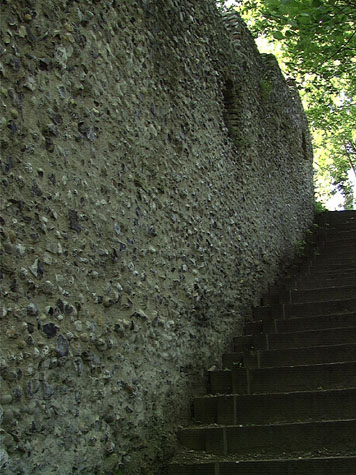
[2] View on the inside of the wall looking up towards the Black
Tower.
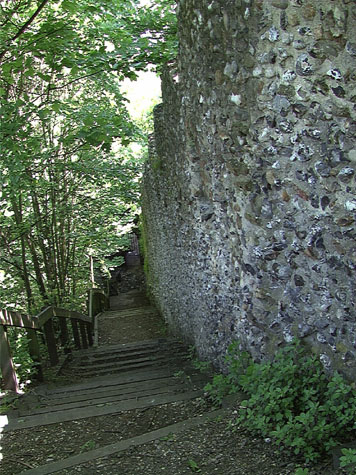
[3] View on the inside of the wall looking down towards the lower
tower.
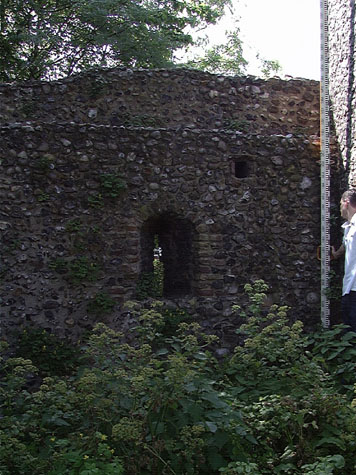
[4] Loop on the inner side of the wall immediately east of the
Black Tower.
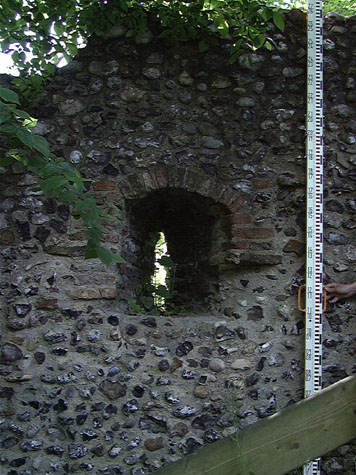
[5] Loop on the inner side of the wall.
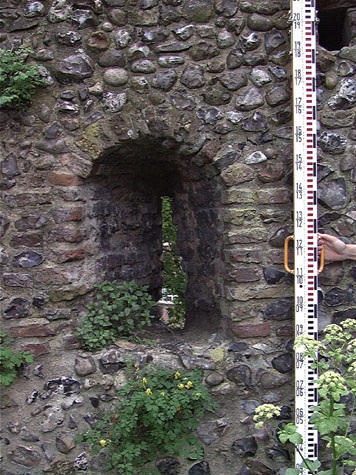
[6] Loop on the inner side of the wall.
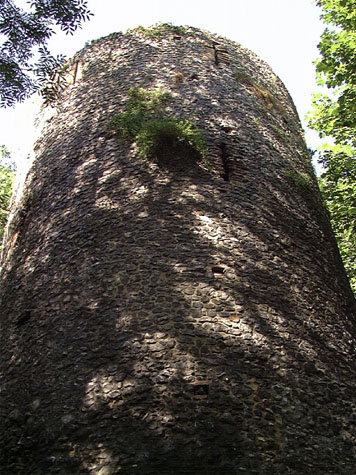
[7] The upper part of the tower from the east.
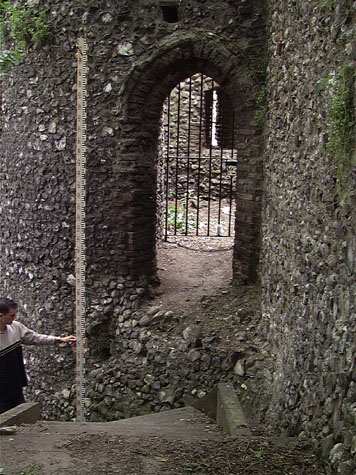
[8] The doorway into the lower tower.
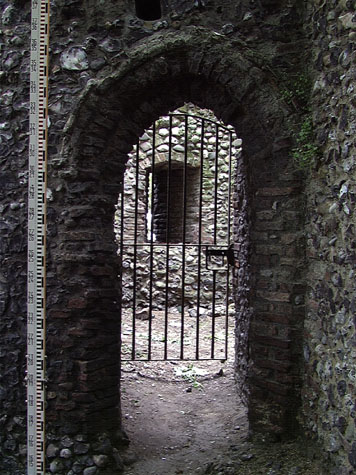
[9] Doorway into the lower tower.
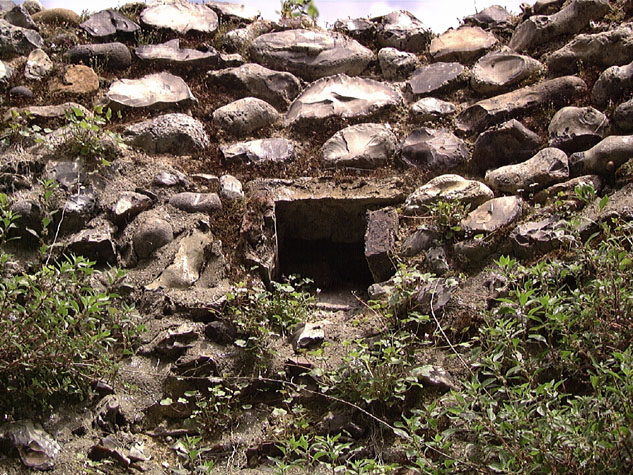
[10] The doorway out of the tower on the west side.
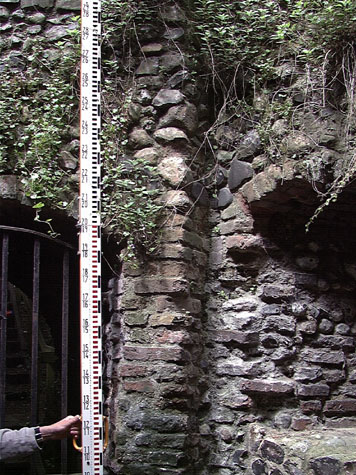
[11] Break forward in wall line north of doorway inside tower.
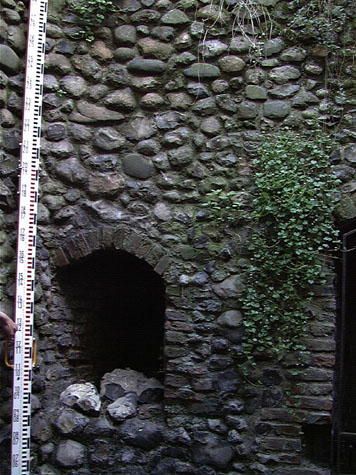
[12] Loop looking back up the outer face of the wall towards the
Black Tower.
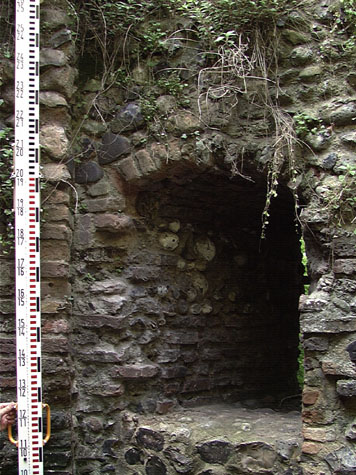
[13] Loop inside tower on the north side.
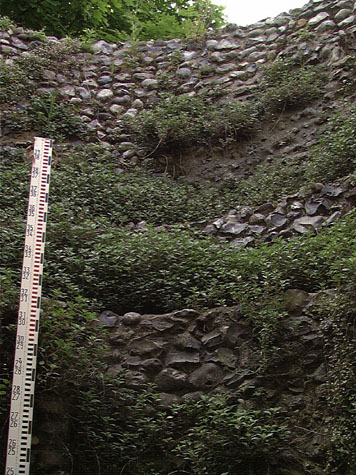
[14] Upper part of the tower with the wall stepping in at the upper
stages.
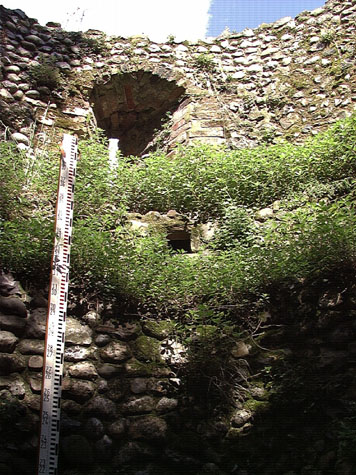
[15] Upper loop inside the tower.
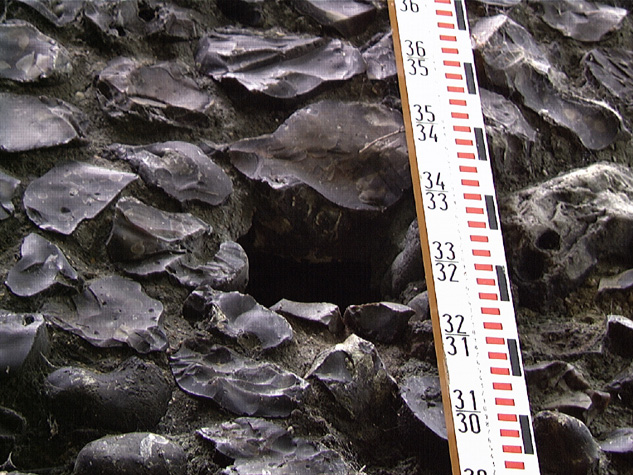
[16] Putlog hole at the lowest level of the tower, below the lower
chamber, without brick lining.
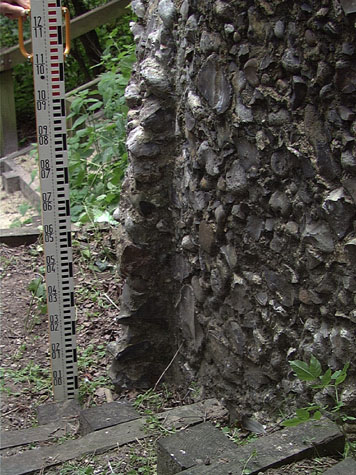
[17] Stub of wall on the north east side of the tower from the wall
that continued down towards King Street.
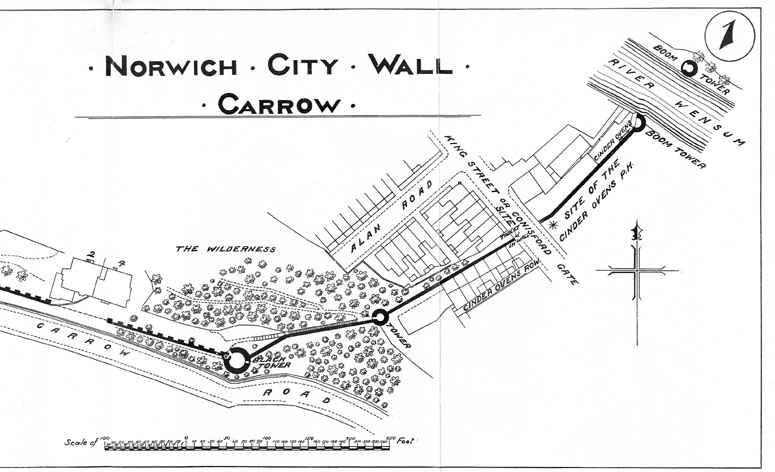
[18] Plan of the wall and towers published in the report of 1910.
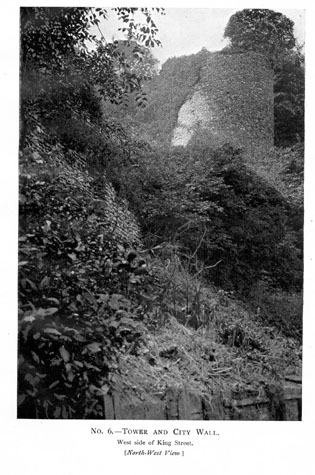
[19] Photograph of the view up to the lower tower from King Street
along the inside of the wall. Published in the report of 1910.
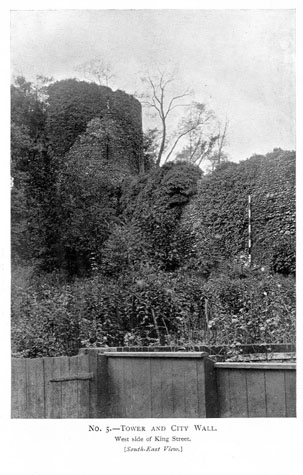
[20] Photograph of the lower tower from the south east, from
outside the wall. Published in the report of 1910.
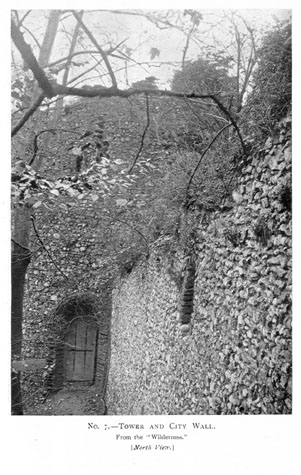
[21] Photograph of the Wilderness Wall and the lower tower from the
west. Published in the report of 1910.
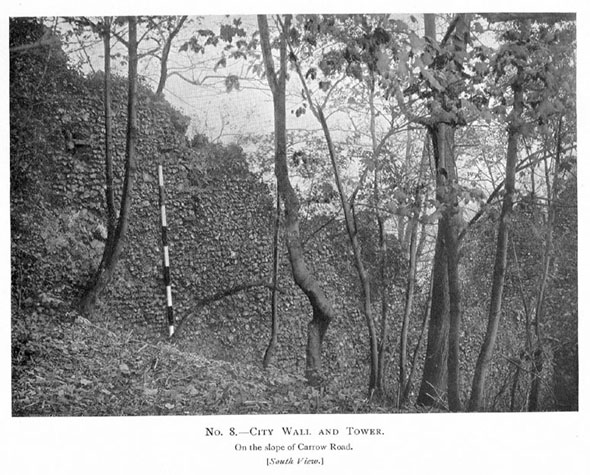
[22] Photograph of the exterior of the wall running down Carrow
Hill.
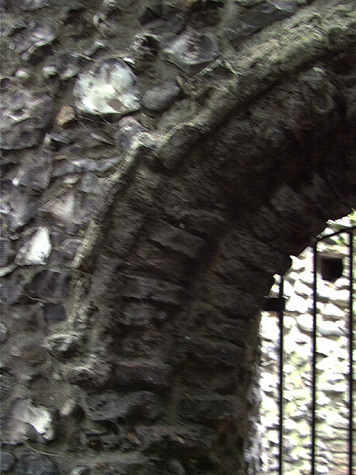
[23] Hood mould of the doorway.
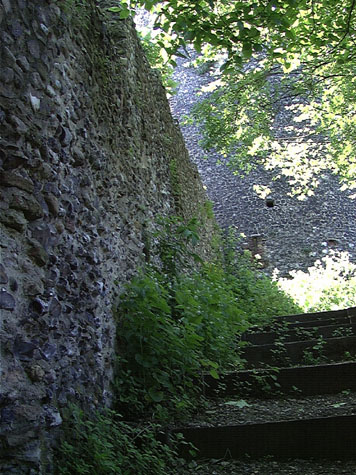
[24] View on the inside of the wall looking up towards the Black
Tower
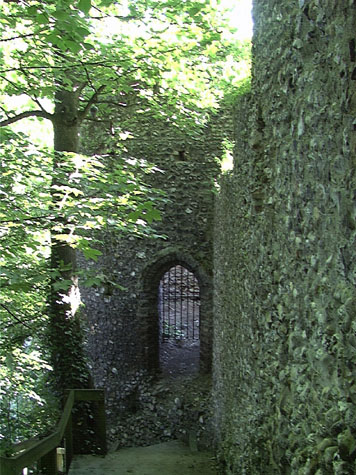
[25] The doorway into the lower tower.
|
Historical Background Report
General description of the historic fabric
The Black Tower and the lower tower are 48 metres apart
and in that distance the ground level drops by 16 metres.
[2 & 3] In fact the slope is so steep that the ground
drops a further 6.7 metres from one side of the lower tower to
the other. The wall descending this steep slope between the
towers is angled inwards on plan and is at most 1.5 metres thick.
[33-01 Plan] The steep gradient of the slope of the ridge
meant that the wall was constructed without arches on the inner
side to support the wall walk. The only section of the wall where
there are arches that step down with the gradient of a slope
are at Barn Road
[report 16] and there, in comparison, the slope is very gradual.
There are, nevertheless, loops in the wall here though widely
spaced with two on the upper part and four after the change of
alignment. These have flattened arched brick heads to the inner
side of the wall and the jambs of the embrasures and the outer
edges of the loops are in brick.
[4, 5 & 6] The report on the wall, produced by Robert Smith
in 1992, sets out which of the bricks are original and which have
been replaced.
The loops are spaced regularly along the wall about 8 metres
apart except for a marginally longer space between the second and
third loop at the angle of the wall.
[33-03 Wall Ext Elev] [33-04 Wall Int Elev] These loops are now
set too high in the wall but the ground level inside the wall is
lower than when the wall was built with as much as 1.5 metres of
the footings exposed in the centre of the wall. It is also possible
that earth was built up in front of each loop to form a simple
level platform.
The wall walk on this section was narrow but there is clear
evidence for an outer parapet. There is no evidence in the towers
for doorways leading out from the towers onto this wall walk so
access must have been by ladders propped against the inner side.
There are brick-lined putlog holes along the whole length of
the wall. At the east end, close to the lower tower, these form
a rational pattern with a series of stepped platforms but at the
west end, closer to the Black Tower, the arrangement is less rational
and it is difficult to see how the scaffold platforms were set up.
In the upper part of the wall there is one inserted gateway that
is now blocked. The shallow arch of the opening has a double line
of headers and the sides of the opening were crudely formed with
some bricks. This gateway is presumably one of the entrances to
the pleasure gardens and probably dates from the late 18th or early
19th century.
The tower has an outer diameter of 6.3 metres and, with thick
outer walls, the internal diameter is just 3.3 metres.
[33-05 Plan] Because of the steep slope of the site, the tower
is just over 6 metres high on the up-hill side, where there is a
doorway into the tower, but over 12.5 metres high on the lower
side towards King Street.
[7] [33-07 Tow Sou Elev] [33-08 Tow Nor Elev] The doorway is
arched with chamfered brick jambs and the remains of a hood
moulding in moulded or rubbed brick.
[8 & 9]
The ground plan of the tower is asymmetrical with a flattened
inner side around the area of the entrance door on the west side.
[10] The door is hard into the internal angle between the tower
and the wall running west up to the Black Tower.
[11] This flattening or bowing out of the wall line stops with
a sharp return back immediately north of the doorway and south
of the doorway includes the first loop that looked back along the
outer face of the wall, up towards the Black Tower.
[33-10 Tow Wes Elev] The reason for the thickening out of the
wall on the west side is unclear.
On the ground level there are four loops including the loop above
looking back up to the Black Tower.
[12] There is a comparable loop on the east side looking down the
outer face of the wall running down to King Street. A third loop
looks straight out to the south and a fourth loop looks north into
the city. [13] It has been suggested that the inward-looking loop
indicated that the tower pre dated the wall and had been free
standing so that it had to be defended to all sides. It seems more
likely that the inner loop allowed a watch to be kept on the river
below and the far bank of the river. It is even possible that
there was an established procedure for signalling from one tower
to another or points within the city that had to be watched for
warning beacons.
Internally, the space within the tower is now 5.6 metres high
although the top of the parapet has been lost and the interior is
partly filled with debris which may bring the floor up by as much
as 400mm above its medieval level.
At the upper level the outer wall has two off sets ... one at
chamber floor level and a narrower inset 700mm higher, just below
the sill of the loops at the upper level approximately 3.25 metres
above the present floor.
[14 & 15] Because of the topography, with the land dropping
sharply away on all sides and with trees growing hard against the
tower it is difficult to look at the external flint work to see if
the offsets, which otherwise have no rational explanation, reflect
a heightening of the tower. It is probably significant that the
lower off set on the inside is at the same level as the wall walk
on the wall uphill towards the Black Tower.
[33-11 Tow Nor Sec] [33-12 Tow Sou Sec] [33-13 Tow Eas Sec] [33-14
Tow Wes Sec]
Topographical drawings of other towers, though no standing
evidence, indicate that some of the intermediate towers were
the same height as the flanking wall and, particularly where
they were semicircular and open on the inner side they can be
seen at a basic level as a bowing out of the wall and its walk.
That is not to suggest that this tower was open on the inner
side but that it simply stopped at the same height as the wall
uphill. There could have been a simple timber platform coming
off the lower offset and the walls above the offset were
thinner as they would have been part of the parapet. If this
surmise is correct then the heightening, if that is what it
is, would have been a relatively early alteration. The upper
part has brick-lined putlogs and four brick-lined loops though
here the loops are all on the outer side.
There is no evidence to indicate how the two-storey tower was
roofed.
On either side of the uphill wall there are substantial chunks
of flint at plinth level acting as bolsters giving the base of the
tower considerable strength. It has to be assumed that the lowest
stage of the tower is solid and that the footings of this were cut
into the slope. There is no evidence to suggest that the tower is
unstable or has ever slipped or shifted down the slope. In fact
several reports have suggested that the wall above the tower is
slipping and is only prevented from moving down the slope by the
tower.
The outer face of the tower has a regular pattern of putlog
holes indicating that there were 7 stages to the scaffolding on
the down hill side. On the south side, the lower putlogs, below
the ground-floor floor level are not lined with brick.
[16]
On the east side of the tower [33-09 Tow Eas Elev] is the
scar of the wall that continued down towards King Street.
[17] This wall was 1.3 metres wide and there is an obvious
outline of the thin outer parapet and the internal wall walk
surviving. As the wall walk is some 8.5 metres below the top
of the tower ... that is well over 2 metres below the floor
level inside the tower ... there can have been no access to the wall
walk from within the tower. There is no sign of a blocked doorway.
The way the flints of the demolished wall have been plucked out
suggest that the wall was not butted up to the tower but the two
were an integral construction.
Documentary evidence:
There are remarkably few historic documents for this section
of the defences. In part this is because this area of the city
was sparsely built up and elsewhere most medieval documents that
survive are related to the purchase or sale of property close
to the wall.
In the early 13th century, the land inside the wall was held
by a priest called Nicholas de Berstrete. About 1216 he granted
the land to Sibrand Prat for 30 shillings. This included part
of the land
'which was John le Botelers, from the Gates of Berestrete,
lying between the land of Carrowe and the King's way, which
extendeth from the Gates of Berestrete to Conesford in breadth,
and in length from the Ditch of the City to the Pathway which
extends from the King's way aforesaid to the Church yard of
St Peter of Southgate.'
[Fitch, page 1]
This was a very large area covering all the steep hillside
from Ber Street Gate to King Street and everything south of that.
The document shows clearly that the city extended as far south as
Conisford Gate by the early 13th century and there was already a
ditch marking the city limit which presumably followed the present
course of the wall down Carrow Hill. It is also interesting that
although Boteler owned the property in the 12th century his name
survived for Carrow Hill is referred to as Butlers Hill until at
least the late 19th century and the Black Tower was variously
referred to as Botelier's Tower or Butler's Tower. Ann,
the daughter of Sibrand granted this property, to the Church of
St Mary along with all her tenements in the city and a mill '
before the Gates of Berstret.'
The wide deep ditch down Carrow Hill does not appear to be a
natural feature. The ridge on which the Black Tower and the lower
tower stand appears to continue on the south side of the road though
the implication of this ditch being man made would involve the removal
of huge amounts of material. In part the dilemma is resolved by
historic documents. There was a lime kiln in the ditch outside
the walls in the 14th century. About 1322 (15th Edward II)
'the Baillives and Commonality of Norwich leased to Thos.
De Byntre and Will. De Wittone for seven years, at 40s. per annum,
a certain common Kiln of the said Commonality, near the Ditch without
Conisford Gates, and liberty to the said Thos. And William to dig
chalk in the Ditch of the said City from the Gates of Conisford towards
the Gates of Berstrete, and to take and burn and carry away and sell
it at their pleasure.
[Lib. Alb. And Domesday Civ. Quoted by Fitch page 2]
Presumably it was the workings of this quarry and kilns that
excavated the deep broad profile of the ditch or valley running
down from the ridge to the river outside the wall.
In 1748 Samuel Bruister acquired the land inside the walls on a
hundred year lease and appears to have opened a pleasure garden here.
[Trevor Fawcett, article on Norwich Pleasure Gardens in Norfolk
Archaeology] In 1768 public breakfasts were held in the gardens
and in the evenings the walls were illuminated and there were
illuminated walks. By 1771 the walls and the gardens were privately
owned and the Black Tower was called Mackarel's Tower.
Blyth's directory of 1842 describes this stretch of wall and
tower as `a good specimen of the ancient manner of fortification.
On the walls ascending the hill is a tower.'
[Blyth, page 5] It is obvious that this is the tower referred to,
as he mentions that the next tower along is the Black Tower.
Map evidence:
Early maps show that the wall and all the intermediate towers
between Ber Street and King Street survived until the late 18th
century. There were no buildings on the line of the ditch and no
buildings inside the walls. However, the maps do provide some
interesting evidence about changes to the landscape around the walls
and towers. On King's map of 1766, the Black Tower is identified
as the Earl of Buckinghamshire's Tower and on Hochstetter's
map of 1789 it is identified as a Snuff Mill. The outer ditch
running down Carrow Hill was dry and was open land with a pathway
winding down from Bracondale to King Street at a point just outside
the gate. There were no buildings along Bracondale apart from
those immediately outside Ber Street Gate. There were also buildings
on either side of Conisford Gate at King's Street and gardens
laid out against the outer side of the wall on the lowest section
below the lower tower.
In the late 18th century and in the first quarter of the 19th
century there was extensive new building work south of the city beyond
the walls and gates. Houses were built along Bracondale. Houses,
factories and wharves were built between Conisford Gate and Carrow
Abbey and about 1817 a new road was constructed running down Carrow
Hill, cutting across King Street and leading to a new Bridge over
the river south of the Boom Towers. All these changes are shown on
Millard and Manning's map of 1830. The ridge on which the wall
and towers stand is too steep for any of these changes to have
really impinged.
By 1873, the year Morant's map was published, the road down
Carrow Hill was called Butlers Hill. By 1885, the year that the
first edition of the Ordnance Survey map was published, the hillside
below Carrow Hill House, running down to St Peter's Church and
King Street, was called the Wilderness.
By 1910, when a map of this section was published in the report
on the walls by A Collins,
[18] Butlers Hill was called Carrow Road. [map 1 opposite page
12] Its name was changed to Carrow Hill later in the 20th century.
By 1910 there were steps set out inside the wall running down the
hill beyond the Black Tower.
Historic views and historic photographs:
A pencil and water colour drawing by Harcourt Bosworth in Norwich
Castle Museum shows the lower tower to the left, with trees and
shrubs to the front and right hand side of the tower. Some ruin of
the wall is visible. The top of the tower is without battlements.
[NCM 1922.135. BH 92:INT] The gate is not visible. The date is
uncertain in the catalogue (1805 or 1905) but given the lack of
gate and the dilapidated state of the tower and wall the
date must be 1905.
Photographs of the tower and the wall up to the Black Tower [19,
20, 21 & 22] were published in the report of 1910.
[Collins, 1910, plates 5-8] The report states that at that stage
the south side of the tower was covered in thick ivy and the outer
face of the wall and tower were crumbling badly particularly along
the top.
[Collins, 1910, page 19] The map published in that report
[Map 1] shows the wall from King Street running up to the east side
of the tower without a break.
Archaeological reports:
A report on the lower tower written by Robert Smith was produced
by the Norfolk Archaeological Unit in March 1992. This is reproduced
in full in the appendix.
CONDITION SURVEY
List of known repairs:
In 1910 Collins reported that on the wall between the
towers, 'the outer face of the wall towards Carrow Road, is
in a very bad state of repair over its whole surface, and the top
is crumbling away into very irregular heights and outline.'
[Collins, 1910, 62-63] It is not clear if any repairs were
undertaken at that stage. Collins suggested that the wall was
unstable and moving down the slope. It had certainly broken away
from the east side of the Black Tower where there was a gap that
he recommended should be
repaired.
A large area of facing flint on the south east side of the
lower tower had collapsed and repairs appear to have been completed
about 1992.
Summary of present condition:
The wall and the tower are in good condition apart from a major
concern about the exposed footings on the inner side of the wall
with loose gravel and soft mortar with few large flints. These
footings are vulnerable both to rain water running down the face of
the wall and to surface water running down the steps. The modern
wooden steps down the inner side of the wall make any repair difficult
and under building of the wall is not desirable and nor may it be
necessary. The problem may not be serious if water does drain away
quickly and the slope is steep. The situation should be monitored to
ensure that the weight of the wall and water penetration do not cause
the wall to move or lean over to the north.
The top of the wall is very irregular and again is vulnerable to
water penetration. Here, with a footpath immediately below the wall,
falling flints are a serious danger.
The wall walk appears to slope outwards to shed water quickly away
to the north side and water penetration does not appear to be a serious
problem at this time. The wall top must be monitored annually and this
could be done in the Spring when self seeded bushes and trees could
also be cleared away.
Principal conservation problems:
- Shedding flints on the face and top of the wall
As stated above the wall top is particularly vulnerable. Recent
restoration on the tower indicates that this is not an immediate
problem. Face flints and the capping of the tower wall are all in
a good state.
- Intrusion of woody stemmed plants
There were buddleia bushes on the wall top close to the lower
tower and on the south side ivy is intruding again. Root tips in
the mortar should all be removed when the main stem in the ground
is pulled out. If these are not removed there will be vigorous
re-growth from the aerial roots seeking moisture in the mortar.
- Deterioration of the brickwork
This is a particular problem on the brickwork of the door
into the tower.
[23] Repair or replacement of bricks is impossible as this would
not only remove the main architectural feature of the tower but
remove the ruinous appearance that here is a positive virtue.
The bricks should be re-pointed where necessary and loose bricks
re-bedded.
[33-14 Tow Door]
|
